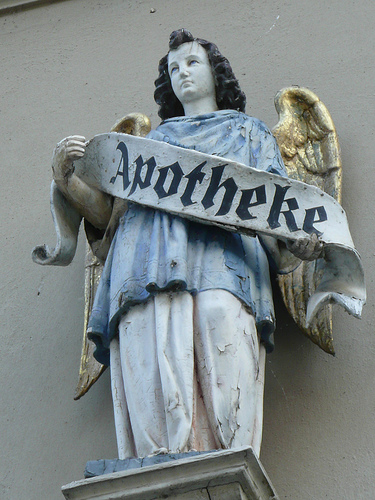.jpg) |
| Angel Pharmacy century there was a pharmacy in Mergentheim. Here is the recipe table (mid-18th century) and the Waaghalter (1753, probably by Johann Georg Oegg) |
 | |||
| City trip to Ravensburg | Old pharmacy sign on the modern angel | Pharmacy. |
 |
| An institution in the "neighborhood" was the angel in the former cafe pharmacy ... since this year |
 |
| Facade of the pharmacy - Oskar Laske (1901-1902) - Vienna |
 |
| Leech jar, England, 1831-1859 |
.png) |
| Pharmacy leech jar, England, 1830-1870 |
.png) |
| Pair of pharmacy storage jars, Naples, Italy, 1756 These earthenware jars are illustrated with scenes from both the Old and New Testaments of the Bible. |
.png) |
| Pharmacy jar, Italy, 1730-1750 This pharmacy jar is illustrated with scenes of a circumcision and three devils’ heads. Entwined snakes form the handles. |
.png) |
| Drug jar showing St John the Baptist, Italy, 1570-1630 |
.png) |
| Pharmacy storage jar for Blessed Thistle Water, Italy, 1702 |
.png) |
| Dispensing pot for Holloway's ointment, England, 1839-1867 |
.png) |
| Dispensing pot for laudanum, Italy, 1771-1830 |
.png) |
| Dispensing pot, Europe, 1746 |
.png) |
| Snake-shaped storage jar, Europe, 1801-1900 |
.png) |
| Albarello drug jar used to store badger fat, Italy, 1585 |
.png) |
| Albarello drug jar, Italy, 1720-1790 |
.png) |
| Pharmacy storage jar used for Theriac, Bordeaux, France, 1725-1755 |
.png) |
| Pharmacy storage jar used for Theriac, Bordeaux, France, 1725-1755 |
.png) |
| Drug jar for cinchona bark, Italy, 1701-1730 This earthenware jar was used to store cinchona bark. Cinchona was used to prevent heavy bleeding and diarrhoea but is better known as a source of quinine. |
.png) |
| Drug jar for cinchona bark, Italy, 1701-1730 |
.png) |
| Glass pharmacy jar for powdered quinine, Europe, 1601-1700 |
.png) |
| Albarello drug jar, Italy, 1600-1700 The decoration of this colourful earthenware drug jar shows the emblem of the Franciscan Order: two arms surrounding a crucifix displaying stigmata. |
.png) |
| Albarello drug jar, Sicily, 1601-1670 |
.png) |
| Albarello drug jar, Sicily, 1601-1670 |
.png) |
| Albarello drug jar for Sanicle, Italy, 1601-1800 |
.png) |
| Drug jar, Italy, 1500-1700 |
.png) |
| Pharmacy jar, used for nerve ointment, The Netherlands, 1730-1780 |
.png) |
| Albarello drug jar, Venice, Italy, 1571-1630 |
.png) |
| Albarello pharmacy jar for mercury ointment, Italy, 1520-1560 |




















.png)
.png)
.png)
.png)
.png)
.png)
.png)



